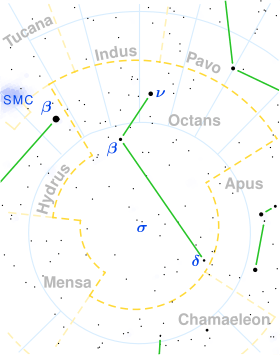Nu Octantis
| Observation data Epoch J2000 Equinox J2000 | |
|---|---|
| Constellation | Octans |
| Right ascension | 21h 41m 28.64977s[1] |
| Declination | −77° 23′ 24.1563″[1] |
| Apparent magnitude (V) | 3.73[2] |
| Characteristics | |
| Spectral type | K1III[3] |
| U−B color index | +0.89[4] |
| B−V color index | +1.00[4] |
| Astrometry | |
| Radial velocity (Rv) | +34.40[5] km/s |
| Proper motion (μ) | RA: +66.41[1] mas/yr Dec.: -239.10[1] mas/yr |
| Parallax (π) | 45.25 ± 0.25[6] mas |
| Distance | 72.1 ± 0.4 ly (22.1 ± 0.1 pc) |
| Absolute magnitude (MV) | +2.10[2] +2.02[7] |
| Orbit[7] | |
| Period (P) | 1050.69+0.05 −0.07 d |
| Semi-major axis (a) | 2.62959+0.00009 −0.00011 AU |
| Eccentricity (e) | 0.23680 ± 0.00007 |
| Inclination (i) | 70.8 ± 0.9° |
| Longitude of the node (Ω) | 87 ± 1.2° |
| Argument of periastron (ω) (secondary) | 74.970 ± 0.016° |
| Semi-amplitude (K1) (primary) | 7.032 ± 0.003 km/s |
| Details | |
| Mass | 1.04[8] 1.61 / 0.585[7] M☉ |
| Radius | 5.9[8] 5.81 ± 0.12[7] R☉ |
| Luminosity | 17.53[2] L☉ |
| Surface gravity (log g) | 3.12 ± 0.10[7] cgs |
| Temperature | 4860 ± 40[6] K |
| Metallicity [Fe/H] | +0.18 ± 0.04[7] dex |
| Rotational velocity (v sin i) | 2.0[7] km/s |
| Age | ~2.5-3[7] Gyr |
| Other designations | |
| Database references | |
| SIMBAD | data |
ν Octantis, Latinised as Nu Octantis. is a spectroscopic binary[9] star in the constellation Octans with a period around 2.9 years.[6] Its apparent magnitude is 3.73.[2] Located around 21.20 parsecs (69.1 ly) distant,[1] the primary is an orange giant of spectral type K1III,[3] a star that has used up its core hydrogen and has expanded. The secondary star is likely a red dwarf from its low mass.[7]
In 2009, the system was hypothesized to contain an exoplanet based on perturbations in the orbital period.[6] A prograde solution was quickly ruled out[10] but a retrograde solution remains a possibility, although the variations may instead be due to the secondary star being itself a close binary,[11] since the formation of a planet in such a system would difficult due to dynamic perturbations.[12]
| Companion (in order from star) |
Mass | Semimajor axis (AU) |
Orbital period (days) |
Eccentricity | Inclination | Radius |
|---|---|---|---|---|---|---|
| b (unconfirmed) | 2.1059 MJ | 1.276 | 414.8 | 0.086 | 112.5° | — |
References
- 1 2 3 4 5 Van Leeuwen, F. (2007). "Validation of the new Hipparcos reduction". Astronomy and Astrophysics. 474 (2): 653. Bibcode:2007A&A...474..653V. arXiv:0708.1752
 . doi:10.1051/0004-6361:20078357. Vizier catalog entry
. doi:10.1051/0004-6361:20078357. Vizier catalog entry - 1 2 3 4 Anderson, E.; Francis, Ch. (2012). "XHIP: An extended hipparcos compilation". Astronomy Letters. 38 (5): 331. Bibcode:2012AstL...38..331A. arXiv:1108.4971
 . doi:10.1134/S1063773712050015. Vizier catalog entry
. doi:10.1134/S1063773712050015. Vizier catalog entry - 1 2 Gray, R. O.; et al. (July 2006). "Contributions to the Nearby Stars (NStars) Project: spectroscopy of stars earlier than M0 within 40 pc-The Southern Sample". The Astronomical Journal. 132 (1): 161–170. Bibcode:2006AJ....132..161G. arXiv:astro-ph/0603770
 . doi:10.1086/504637.
. doi:10.1086/504637. - 1 2 Mallama, A. (2014). "Sloan Magnitudes for the Brightest Stars". The Journal of the American Association of Variable Star Observers. 42: 443. Bibcode:2014JAVSO..42..443M.Vizier catalog entry
- ↑ Wilson, R. E. (1953). General Catalogue of Stellar Radial Velocities. Carnegie Institution for Science. Bibcode:1953GCRV..C......0W. LCCN 54001336.
- 1 2 3 4 Ramm, D. J.; Pourbaix, D.; Hearnshaw, J. B.; Komonjinda, S. (April 2009). "Spectroscopic orbits for K giants β Reticuli and ν Octantis: what is causing a low-amplitude radial velocity resonant perturbation in ν Oct?". Monthly Notices of the Royal Astronomical Society. 394 (3): 1695–1710. Bibcode:2009MNRAS.394.1695R. doi:10.1111/j.1365-2966.2009.14459.x.
- 1 2 3 4 5 6 7 8 9 10 Ramm, D. J.; et al. (2016). "The conjectured S-type retrograde planet in ν Octantis: more evidence including four years of iodine-cell radial velocities". Monthly Notices of the Royal Astronomical Society. 460 (4): 3706–3719. Bibcode:2016MNRAS.460.3706R. arXiv:1605.06720
 . doi:10.1093/mnras/stw1106.
. doi:10.1093/mnras/stw1106. - 1 2 Allende Prieto, C.; Lambert, D. L. (1999). "Fundamental parameters of nearby stars from the comparison with evolutionary calculations: Masses, radii and effective temperatures". Astronomy and Astrophysics. 352: 555. Bibcode:1999A&A...352..555A. arXiv:astro-ph/9911002
 . Vizier catalog entry
. Vizier catalog entry - ↑ Eggleton, P. P.; Tokovinin, A. A. (September 2008). "A catalogue of multiplicity among bright stellar systems". Monthly Notices of the Royal Astronomical Society. 389 (2): 869–879. Bibcode:2008MNRAS.389..869E. arXiv:0806.2878
 . doi:10.1111/j.1365-2966.2008.13596.x.
. doi:10.1111/j.1365-2966.2008.13596.x. - ↑ Eberle, J.; Cuntz, M. (October 2010). "On the reality of the suggested planet in the ν Octantis system". The Astrophysical Journal. 721 (2): L168–L171. Bibcode:2010ApJ...721L.168E. doi:10.1088/2041-8205/721/2/L168.
- ↑ Morais, M. H. M.; Correia, A. C. M. (February 2012). "Precession due to a close binary system: an alternative explanation for ν-Octantis?". Monthly Notices of the Royal Astronomical Society. 419 (4): 3447–3456. Bibcode:2012MNRAS.419.3447M. arXiv:1110.3176
 . doi:10.1111/j.1365-2966.2011.19986.x.
. doi:10.1111/j.1365-2966.2011.19986.x. - ↑ Gozdziewski, K.; Slonina, M.; Migaszewski, C.; Rozenkiewicz, A. (March 2013). "Testing a hypothesis of the ν Octantis planetary system". Monthly Notices of the Royal Astronomical Society. 430 (1): 533–545. Bibcode:2013MNRAS.430..533G. arXiv:1205.1341
 . doi:10.1093/mnras/sts652.
. doi:10.1093/mnras/sts652.
